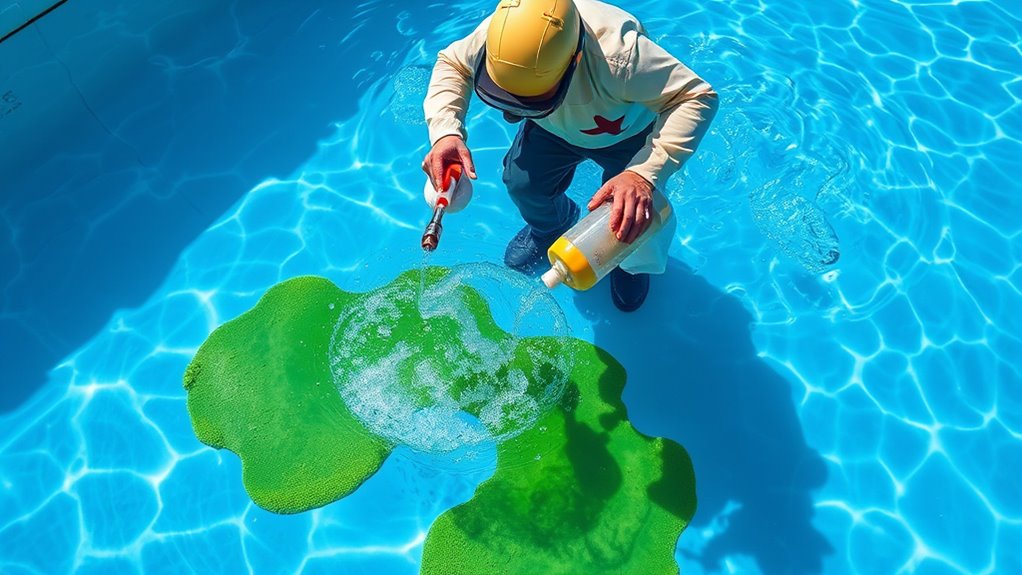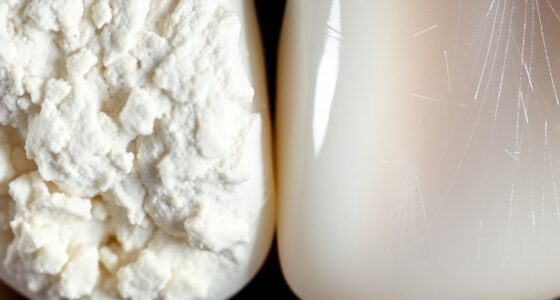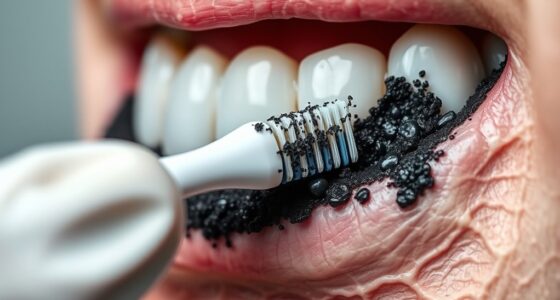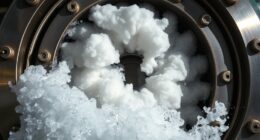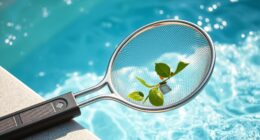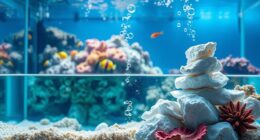To safely eradicate stubborn algae, you need to perform a high-chlorine shock when standard treatments fail or contamination is severe. Start by preparing your pool: clear debris, brush surfaces, and adjust pH to 7.2–7.6. Measure chlorine levels carefully and disperse the appropriate amount evenly, wearing protective gear. Keep the area ventilated and monitor levels closely. Maintaining proper water chemistry and regular shock treatments afterward will help keep algae away. Continue for more detailed steps and safety tips.
Key Takeaways
- Remove debris and algae, then brush pool surfaces to enhance chlorine effectiveness.
- Adjust pH to 7.2–7.6 for optimal chlorine disinfection.
- Calculate and evenly disperse high chlorine dose to reach 10-20 ppm shock level.
- Wear protective gear and ventilate area during application to ensure safety.
- Keep the pool closed and monitor chlorine levels until water is safe for use.
Understanding When and Why to Use High Chlorine Levels
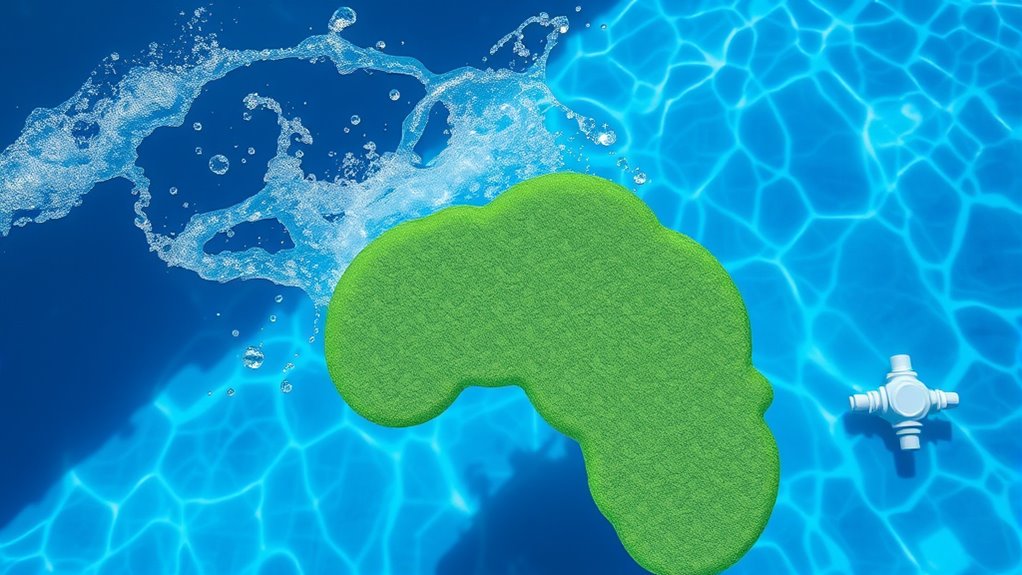
High chlorine levels are essential in specific situations to effectively disinfect water and eliminate harmful pathogens. You should use high chlorine levels when dealing with severe contamination, stubborn algae, or after a sanitation failure. If bacteria or algae are persistent despite regular chlorination, increasing the chlorine concentration helps break down biofilms and eradicate resistant organisms. High chlorine levels are also necessary when shocking the pool after heavy rain, organic debris, or if the water becomes cloudy or foul-smelling. This approach guarantees the water reaches a safe, sanitized state quickly. Remember, applying high chlorine doses isn’t routine; it’s a targeted strategy for challenging situations. Using chlorine responsibly in these cases safeguards your pool while preventing potential health hazards for swimmers. Additionally, maintaining proper color accuracy ensures that any residual algae or contaminants are more visible during treatment, facilitating more effective eradication efforts.
Preparing Your Pool for the Chlorination Process

Before applying a high-chlorination treatment, it’s important to properly prepare your pool to guarantee the process is effective and safe. Start by cleaning the pool thoroughly—remove leaves, debris, and algae from the surface and bottom. Brush the walls and tiles to loosen stubborn algae and dirt, ensuring the chlorine can work more efficiently. Test your water’s pH level and adjust it to between 7.2 and 7.6, as this optimizes chlorine’s effectiveness. Check the cyanuric acid levels and adjust if necessary to prevent chlorine degradation. Turn off your pool’s circulation system temporarily, so the chlorine can evenly distribute. Also, ensure all pool equipment is in good working order to avoid any safety issues during the chlorination process. Proper preparation sets the stage for successful algae eradication, especially since indoor air quality can be significantly affected by stagnant or contaminated air, emphasizing the importance of a clean environment before treatment.
Step-by-Step Guide to Applying a High-Chlorine Shock
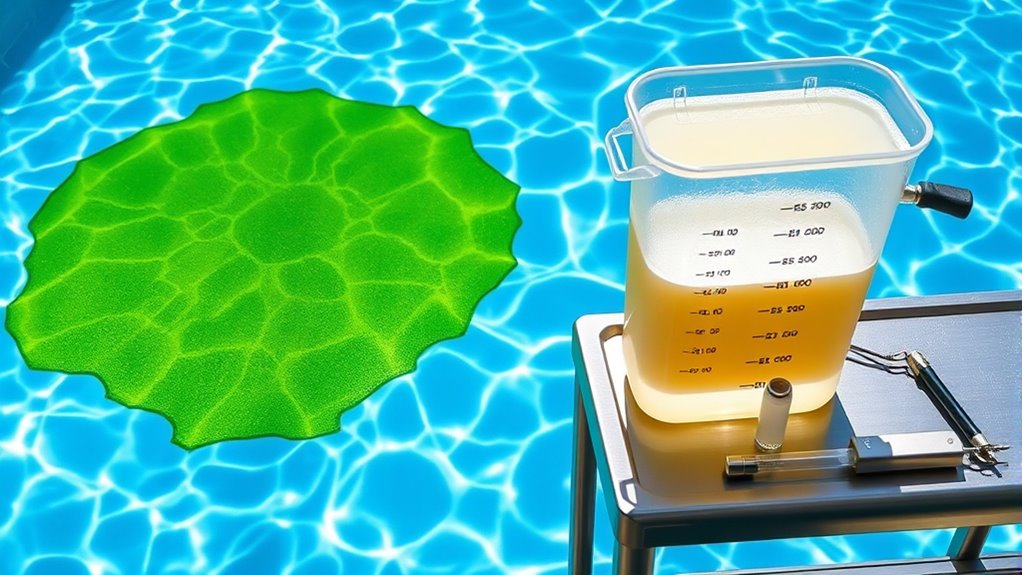
To apply a high-chlorine shock effectively, start by measuring the current chlorine level with a reliable test kit. Once you know the reading, calculate the amount of chlorine needed to reach the desired shock level, typically 10-20 ppm. Wear protective gloves and goggles to handle the chlorine safely. Next, add the chlorine directly to the pool water, dispersing it evenly around the pool’s perimeter. Use a brush or pool pole to stir the water slightly, ensuring thorough mixing. Avoid swimming until chlorine levels drop back to safe ranges. Keep the pool uncovered to allow chlorine fumes to dissipate. Finally, test the chlorine levels periodically to confirm the shock has been properly applied, and prepare to move on to the next safety step. Maintaining proper sanitation and maintenance is essential for preventing algae recurrence and ensuring a safe swimming environment.
Ensuring Safety During and After Chlorination

While chlorinating your pool, ensuring safety is vital to protect yourself and others. Always wear protective gear like gloves and goggles to prevent skin and eye irritation. Ventilate the area well to avoid inhaling chlorinated fumes. After treatment, keep children and pets away until chlorine levels drop to safe ranges. Use a test kit to monitor chlorine and pH levels regularly. Here’s a quick safety overview:
| Step | Action | Precaution |
|---|---|---|
| During | Wear protective gear | Avoid direct contact |
| After | Ventilate area | Prevent inhalation |
| Monitoring | Test levels frequently | Maintain safe chlorine levels |
| Post-treatment | Secure pool area | Keep others safe |
Following these steps ensures safe handling during and after chlorination. Properly maintaining chlorine levels helps prevent health issues and ensures the safety of all pool users.
Post-Treatment Maintenance for Long-Term Algae Control
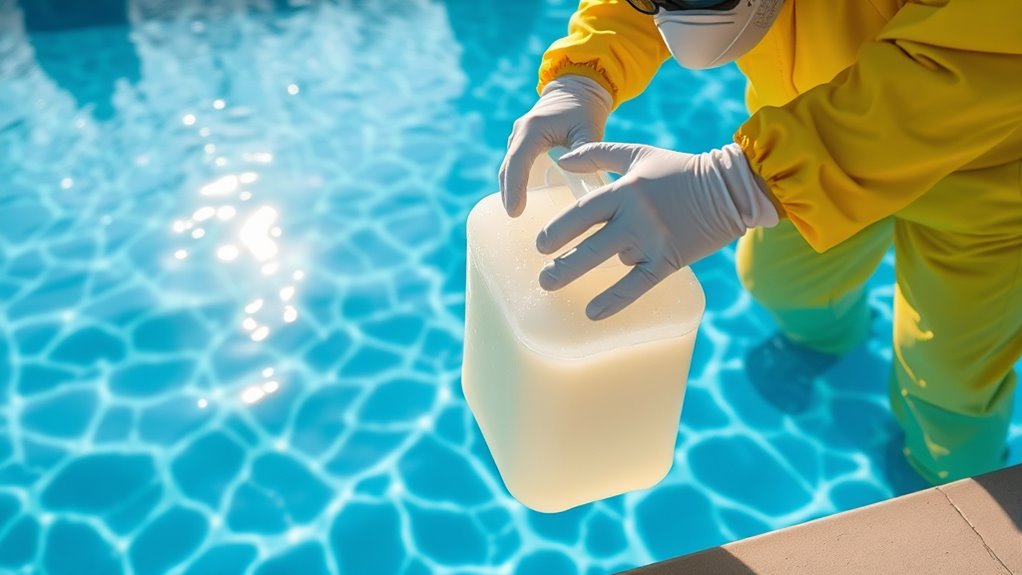
Once you’ve completed chlorination and verified that chlorine levels are safe, maintaining your pool becomes key to preventing algae growth over the long term. Regularly test your water to ensure consistent chlorine and pH levels, ideally maintaining free chlorine between 1-3 ppm and pH around 7.4-7.6. Shock your pool weekly during peak use or after heavy rain to keep algae at bay. Keep your filtration system running efficiently to circulate and filter water continuously. Remove debris and clean your pool surfaces regularly to prevent algae spores from settling. Consider adding an algaecide as a preventive measure, especially in warmer months. Proper vessel maintenance ensures your pool remains clean and algae-free, reducing the need for high-chlorination treatments in the future.
Frequently Asked Questions
What Are the Potential Risks of Over-Chlorination?
If you over-chlorinate, you risk damaging your pool’s equipment, causing corrosion and leaks. It can also lead to skin and eye irritation for swimmers and produce harmful chlorinated byproducts. Excess chlorine may upset your pool’s pH balance, making water unsafe and uncomfortable. To avoid these issues, always measure chlorine carefully, follow recommended guidelines, and thoroughly dilute or neutralize excess chlorine before using your pool again.
Can High Chlorine Levels Damage Pool Equipment?
Yes, high chlorine levels can damage your pool equipment. Excessive chlorine can corrode metal parts, degrade rubber seals, and weaken plastic components over time. This can lead to leaks, equipment failure, and costly repairs. To prevent damage, always follow recommended chlorination levels, avoid prolonged exposure to high chlorine concentrations, and regularly inspect and maintain your pool equipment. Proper balancing guarantees safe, effective algae eradication without risking equipment harm.
How Often Should High-Chlorination Treatments Be Repeated?
You should repeat high-chlorination treatments every 7 to 10 days if algae persists or returns. Always test your water after each treatment to guarantee chlorine levels stay within safe ranges, and avoid overdoing it to prevent equipment damage. Regular maintenance, proper filtration, and balanced pH help reduce the need for frequent high-chlorine shocks, keeping your pool safe and clean without risking your equipment’s longevity.
Are There Alternative Methods to Eradicate Stubborn Algae?
Imagine battling a relentless wave of algae that refuses to fade—there are alternatives to high-chlorination. You can try UV sterilization, which uses ultraviolet light to destroy algae cells without chemicals, or introduce beneficial algae-eating bacteria that naturally curb growth. Mechanical removal with a pool brush or vacuum also helps. Combining these methods with proper chemical balance guarantees a safer, more eco-friendly approach to keeping your pool crystal clear.
What Signs Indicate the Need for a High-Chlorination Protocol?
You should consider a high-chlorination protocol when algae coverage becomes extensive, covering more than 50% of your pool surfaces, or if standard treatments fail to clear the growth after a few attempts. Also, if you notice persistent algae despite regular scrubbing and chemical use, it’s time to escalate. Strong algae blooms and cloudy water are clear signs you need to increase chlorine levels safely to effectively eliminate the problem.
Conclusion
By following this high-chlorination protocol, you’ll effectively eliminate stubborn algae and keep your pool crystal clear. Did you know that proper shock treatments can reduce algae growth by up to 80%? Regular maintenance combined with safe, high-chlorine shocks not only restores your pool’s beauty but also safeguards your health. Stay vigilant, follow these steps carefully, and enjoy a pristine swimming environment all season long.
